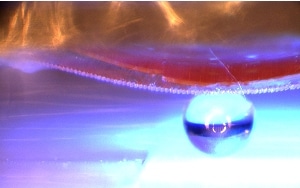Jan 25 2017
 When illuminated with UV light, the intelligent material with the adhesive surface bends. This way it can lift, transport and put down flat and three-dimensional objects (here, a 1 mm diameter glass ball). Photo/Copyright: Emre Kizilkan
When illuminated with UV light, the intelligent material with the adhesive surface bends. This way it can lift, transport and put down flat and three-dimensional objects (here, a 1 mm diameter glass ball). Photo/Copyright: Emre Kizilkan
Adhesive mechanisms can be observed in the natural world as seen in geckos and other animals that use it to walk upside down on the ceiling. These natural mechanisms have several benefits: for instance they are eternally strong adhesive - and without any residues or glues.
Researchers at Kiel University are exploring ways to artificially develop these mechanisms. An interdisciplinary research team from Materials Science, Biology, and Chemistry have successfully developed a bio-inspired adhesive material that can be manipulated remotely using UV light.
This approach makes it possible to precisely move objects in a micro-range. The findings may be of use for applications in the fields of industry, robotics, and medical technology. The results of the Kiel-based research team were published on 18 January in the scientific journal Science Robotics.
In nature, mechanical stimuli such as muscle movements ensure that the legs of the animal stick to surfaces and can then be detached again. The Kiel researchers are using light to manipulate their artificial adhesive mechanism instead, which they built based on models found in nature.
The advantage of light is that it can be used very precisely. It is reversible, so it can be switched on and off again, and that very quickly.
Emre Kizilkan, Kiel University
Kilzikan is from the Functional Morphology and Biomechanics research group under Professor Stanislav Gorb at the Zoological Institute.
The team first developed an elastic porous material (LCE, liquid crystal elastomer) with the capacity to bend when illuminated with UV light. This was possible due to the material’s special molecular structure. During the development phase, they realized that the more porous the material, the more it bent, and the researchers used this fact.
Due to their structures, porous materials can be very easily incorporated to other materials. So we tested what happens when we combined the elastic material, which reacts well to light, with a bio-inspired material that has good adhesive properties.
Emre Kizilkan, Kiel University
The outcome is an intelligent composite material with adhesion feature that can be controlled using light. The surface is made up of mushroom-shaped adhesive microstructures, similar to ones found on the feet of certain species of beetle. Flat or 3D small elements such as glass spheres or microscope slides can attach and be picked up.
The material bends when the composite material is illuminated using UV light. Due to the continually bending of the surface, adhesive elements detach from the object, until it finally drops down again.
We were able to show that our new material can be used to transport objects. Moreover, we demonstrated that the transport can be controlled very precisely with light – on a micro-level.
Emre Kizilkan, Kiel University
Gorb adds: “We use light as a remote control, so to say. Our bio-inspired adhesive material doesn’t leave any residues on the objects, either.”
The research team’s findings are therefore particularly interesting when developing micro computer chips or sensitive sensors. They have to be produced in an environment that is protected from external impurities and influences, such as Kiel University’s cleanroom. “In the long term, we would like to use the new material to develop micro-robots which can be controlled by light to move forwards and climb walls,” is Professor Gorb’s insight.